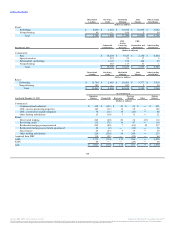BB&T 2014 Annual Report Download - page 99
Download and view the complete annual report
Please find page 99 of the 2014 BB&T annual report below. You can navigate through the pages in the report by either clicking on the pages listed below, or by using the keyword search tool below to find specific information within the annual report.
Table of Contents
A portion of the ALLL may not be allocated to any specific category of loans. Any unallocated portion of the ALLL reflects management’s best estimate of
the elements of imprecision and estimation risk inherent in the calculation of the overall ALLL. During 2013, BB&T incorporated these elements into the
ALLL determination for each loan category such that there is not an unallocated ALLL as of December 31, 2014 or 2013.
The entire amount of the ACL is available to absorb losses on any loan category or lending-related commitment.
The following provides a description of accounting policies and methodologies related to each of the portfolio segments:
Commercial
The vast majority of loans in the commercial lending portfolio are assigned risk ratings based on an assessment of conditions that affect the borrower’s ability
to meet contractual obligations under the loan agreement. This process includes reviewing borrowers’ financial information, historical payment experience,
credit documentation, public information, and other information specific to each borrower. Risk ratings are reviewed on an annual basis for all credit
relationships with total credit exposure of $1 million or more, or at any point management becomes aware of information affecting the borrowers’ ability to
fulfill their obligations.
Risk Rating Description
Pass Loans not considered to be problem credits
Special Mention Loans that have a potential weakness deserving management’s close attention
Substandard Loans for which a well-defined weakness has been identified that may put full collection of contractual cash flows at
risk
For commercial clients with total credit exposure less than $1 million, BB&T has developed an automated loan review system to identify and proactively
manage accounts with a higher risk of loss. The “score” produced by this automated system is updated monthly.
During 2013 and 2012, BB&T reviewed all commercial lending relationships with outstanding debt of $5 million or more that were classified as substandard.
During the first quarter of 2014, this process was revised such that any obligor with an outstanding nonaccrual balance of $3 million or more is reviewed.
While this review is largely focused on the borrower’s ability to repay the loan, BB&T also considers the capacity and willingness of a loan’s guarantors to
support the debt service on the loan as a secondary source of repayment. When a guarantor exhibits the documented capacity and willingness to support the
loan, BB&T may consider extending the loan maturity and/or temporarily deferring principal payments if the ultimate collection of both principal and
interest is not in question. In these cases, BB&T may not deem the loan to be impaired due to the documented capacity and willingness of the guarantor to
repay the loan. Loans are considered impaired when the borrower (or guarantor in certain circumstances) does not have the cash flow capacity or willingness
to service the debt according to contractual terms, or it does not appear reasonable to assume that the borrower will continue to pay according to the
contractual agreement. BB&T establishes a specific reserve for each loan that has been deemed impaired based on the criteria outlined above. The amount of
the reserve is based on the present value of expected cash flows discounted at the loan’s effective interest rate and/or the value of collateral, net of costs to
sell. In addition, beginning with the first quarter of 2014, BB&T reviews any collateral-dependent commercial loan balances between $1 million and $3
million to establish a specific reserve based on the underlying collateral value.
BB&T also has a review process related to TDRs and other impaired loans that are in commercial lending relationships with outstanding debt of less than $1
million at the balance sheet date. In connection with this process, BB&T establishes reserves related to these loans that are calculated using an expected cash
flow approach. These discounted cash flow analyses incorporate adjustments to future cash flows that reflect management’s best estimate of the default risk
related to TDRs based on a combination of historical experience and management judgment.
BB&T also maintains reserves for collective impairment that reflect an estimate of losses related to non-impaired commercial loans as of the balance sheet
date. Embedded loss estimates for BB&T’s commercial loan portfolio are based on estimated migration rates, which are based on historical experience, and
current risk mix as indicated by the risk grading process described above. Embedded loss estimates may be adjusted to reflect current economic conditions
and current portfolio trends including credit quality, concentrations, aging of the portfolio, and significant policy and underwriting changes.
98
Source: BB&T CORP, 10-K, February 25, 2015 Powered by Morningstar® Document Research℠
The information contained herein may not be copied, adapted or distributed and is not warranted to be accurate, complete or timely. The user assumes all risks for any damages or losses arising from any use of this information,
except to the extent such damages or losses cannot be limited or excluded by applicable law. Past financial performance is no guarantee of future results.
























